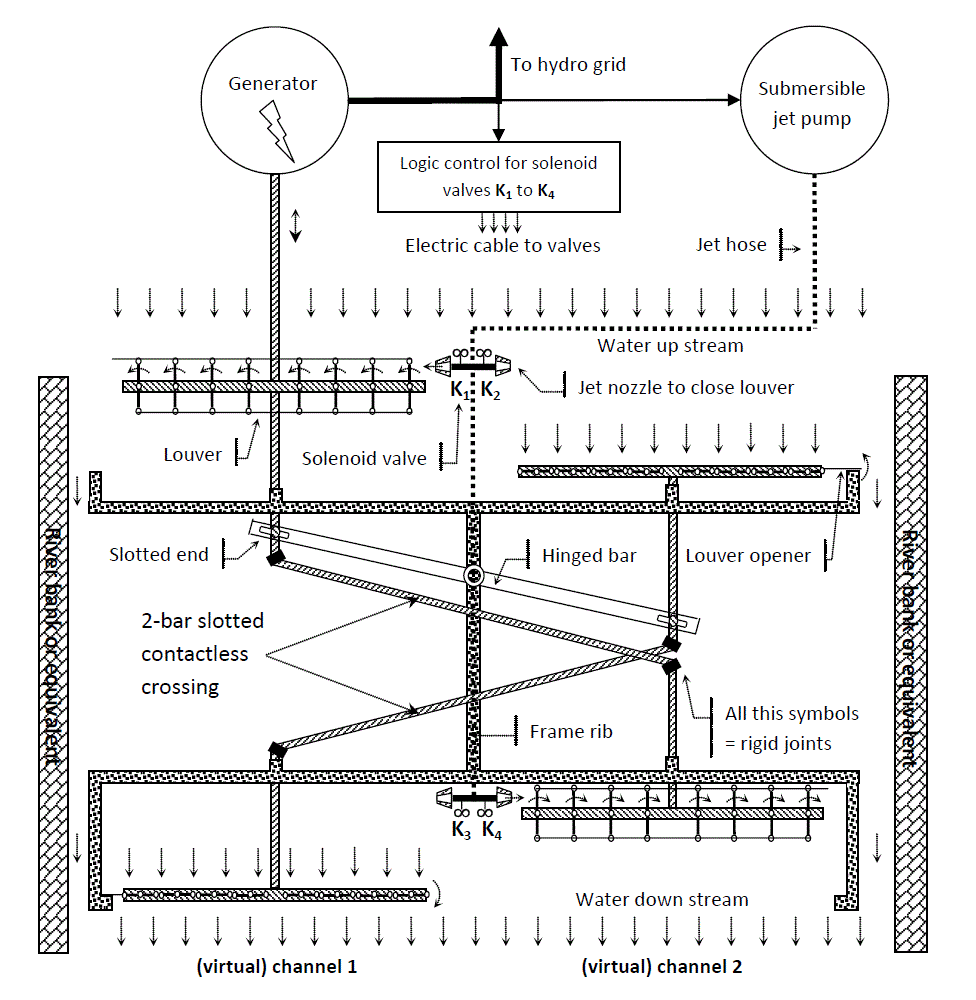不久前申请了一项发明专利,涉及低水头小水电的清洁能源技术。最近写了一篇英文论文,暂时上传到预印本服务器,现全文贴到我的博客,供大家研究参考,欢迎评头品足提意见。
其实原理很简单,仔细研判插图就能搞明白咋回事。
传统旋转式透平已经得到广泛应用,为何我要别出心裁搞复杂的平板式驱动透平?显然,前者的扇叶与水流夹角为锐角,且扇叶之间空隙很大,而我的则垂直,且全部截面受力,因而平板式效率能发挥到极限,且矩形截面更适合于河道。恕我冒昧估计,效率也许高出扇叶式旋转透平10倍?
尽管不用百叶窗,直接用整板,理论上也可以,但是体积太庞大,且在河道里翻转90度很麻烦。
用百叶窗叶还有一个好处:透平截面不一定非要严格矩形,理论上可以任意形状。
整个系统类似于在河道上架设自动开关水闸,任意时刻,在截面上的每一处都存在水流推力。
该发明类似于桥式可控硅电子逆变装置,只不过电流换成了水流,将直流水流,逆变成输出连杆的往复式交流运动。百叶窗的翻转触发一部分用高压射流,一部分靠框架的突缘,类比可控硅的控制栅极。
虽然触发翻转要用一点能量,但只要远小于采集到的流水动能,就是合算的。其实叶条只要偏转很小的角度,后续就可借水流作用力,完成90度翻转,因而触发能量的供应只是一霎那。
祖国河流秀美,资源丰富,如能用上此新能源,善莫大焉!欢迎洽谈合作转让事宜。
下图原本在文中,为方便阅读,特提前到此。

Fig. 1 river or stream low head hydro generator
Shutter-like fluiddriven motor and tide power harvest system
Abstract
Why we haveto be addictive to rotary turbine for tide or wind energy harvest? Perhaps weare not smart enough to find a new way. Now I propose a rectangular crosssection turbine that works in reciprocation mode to harvest energy from anyflowing fluid. In a sense, fluid flows in similar way of electric DC (DirectCurrent), but reciprocal motion of device’s ram behaves in similar way of AC(Alternating Current), thus a DC-ACmechanic inverter is needed.Of course, inverse utilization of same mechanism renders an AC-DC mechanicrectifier, i.e. an exotic pump.
Introduction
The renewable energy is soplentiful, especially a great source of the running water hydrodynamic energyin all rivers and oceans. Nowadays, only high water head resources can beeffectively utilized for hydro electricity, but the main resource is of lowwater head, and never well developed in prior arts, though some experimentaltidal turbine projects are under research, such as the Fundy bay tidal energyproject in Canada.
Here I present ashutter-like fluid-driven motor and try to apply it to the tidal power harvestsystem, as showed in fig. 1, of course, it can apply to any low head rapidriver or stream.
How it works?
Shutter-like, aka louver-likemotor, categorized in class of board motors, is basically the planar type thatreceives mechanic energy directly by planar surface from energy carrying fluidwhich current direction is vertical to the said surface, not by rotating bladesas in traditional rotary turbines where fluid direction is never vertical toany blade, but a small angle; and usually the former can interface either asquare or rectangular or even more complicated area with fluid power, but thelatter only circular area.
For cycling work, all boardmotors including shutter-style, must run in reciprocal movement.
Abstractly, the board motorabsorbs direct current energy of unidirectional flowing fluid, such as runningwater, and converts it into alternating “current” or motion of rigid movable parts,e.g. ram, in reciprocal mode, and so, in a sense, it is a special DC-ACconverter or inverter.
Run with the unidirectionalflow produces effective work, anyway for recycling run, retraction is a mustfor next reciprocal cycle, but retraction is always counter-current, that iswhy the interfacing area perpendicular to flow direction should be reduced toalmost zero during retraction by whatever feasible method for save of overhead energyused by internal operation.
In 2-board mode(undrawn in fig. 1), hinging 2 parallel shafts via an end-slottedbar with central pivot pin, the 2 boards can work in 180° phasedifference that means one board’s retraction can always be assisted by theother forwarding board pushed by fluid.
Update to 4-boardmode is simple, as showed in fig. 1: just combining the two pairs ofboards to form quartet in cross linkage configuration, the entire workinginterface area can be 100% ofstream vertical cross section, if not then only 50%.
The quartet assemblyvirtually divides the whole stream to 2 quasi fluid channels, and if aseparator wall is inserted in between, though unnecessary, then 2 channelswill realize.
The crossing linkage can bedone by rigid joint of opposite boards in separate channels, thus, the boardsin same channel always run in opposite direction.
To fix the space conflict,one of the two crossing bars can be slotted in middle quoted range, and theother bar runs through the slot.
For large planar motor, asingle board can be hard to flip for toggle of interfacing area, because ofeither non-negligible toggle energy consumption, or not enough turn aroundroom, that is why a shutter style motor is proposed, because every single vaneof shutter is just a fractional area of the whole.
Compared with the fullshutter board area, the power interface area of shutter rib-frame is almostnegligible, so it is not necessary to flip the big size rib-frame, but justonly toggling all vanes of the shutter is enough.
Toggling the shutter isidentical to say open or fold or close or unfold shutter in semantics, andwhere open shutter is mentioned, then it means fluid can pass the shutter andthe shutter is in retraction stroke; otherwise the shutter is confronting fluidand in working stroke.
In the figure, closing orunfolding shutter is done by water jet, and opening or folding shutter byflange hit, though water jet can be optional.
The timing of shutter toggleis important for efficient energy harvest, and solenoids can execute timinginstructions from logic control module.
The water jet is produced byjet pump, and mini-size could be okay because of low energy consumption oftoggling shutter. The absolute pressure of water jet is better to equal thefluid static pressure plus atmosphere pressure plus a threshold value that isdetermined by engineering conditions, because if too high then not economicelse if too low unworkable.
In fact, toggling vanes ofshutter should not be only credited to the jet power, but also the subsequentfluid power, because the yaw effect of fluid will assist and quicken thetoggling transition, though the jet initialized or triggered and created thevane’s non-equilibrium state, and that is also the reason why toggling energyis negligible.
For convenience ofcharacterization, as the operating rationale aka working principle is wellexplained in context of all above description, I abstract and define such arationale as fluid-DC-AC that means the unidirectional fluid pushesvanes that are alternatively changing orientation in parallel or vertical tostream by aforementioned mechanism so as to output mechanic energy duringreciprocal movement. It applies to both planar and quasi planar vanes, such asplain board, shutter-like, or even umbrella-like.
By narrowing a waterway, thewater current velocity can be increased significantly, so as to harvest moreenergy, as the illustrated river banks in the figure.
As a rule of thumb, fluidmotor is submersed in stream, generator is mounted on platform over water bodyand anchored to riverbed, and most applications work in shallow water exceptocean application.
Coupling the fluid motor andabove-water generator is via transmission, such as sprocket mechanism, thoughdirect coupling may work if the generator is well water-sealed for submersibleuse and not big enough to block waterway.
Comparison with rotary turbine
Obviouslythe blades of a rotary turbine can only occupy very small percentage of wholecircular area, and there is a small angle between fluid force and blade surfaceso as to induce torque for rotation.
Aquartet board turbine, usually in rectangular shape, can make full use of allcross section area of running fluid, and flowing force directly push boardsforward, such advantages can over-perform far greatly than the regular simplerotary turbine.
Theloss of rotary turbine is only caused by friction, but for a turbine of boardtype, extra overhead energy is needed for driving jet pump and logic controllerand solenoid valves.
Aslong as the fluidic power can cover the said overhead energy, i.e. overcomingthe breakeven threshold, then the fluid-DC-AC mechanism can work.
Generallyspeaking, the overhead energy is very low, and none river holds dead water, sowhatever low head river resource can be utilized for energy production withthis invention.
Ifdeployed in water body, such system is safe for fishes, unlike rotary turbinescan kill fishes.
Thismechanism can also be utilized to harvest wind energy where an air compressorreplaces jet pump, but a yawing system or other complicated control system isneeded to track wind direction. Such system almost has no noise, and is safefor birds.
Extended application – the fluid-AC-DC reciprocal pump
Itis well known that most electric motors can also be used as generators withminor modification, though efficiency could be very low.
Thisis also true in fluid circuit.
Therefore, herein fluid-DC-AC motor can also be used as fluid-AC-DC pump with minor logicconfiguration, but the static leaking of fluid may frustrate some applicationsif substantial modification is not done.
Postscript
Fordetails, please check out my pending patent US15/267,122.

